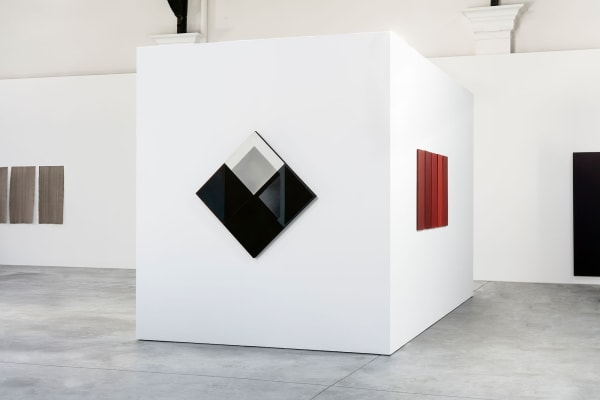AU GRE DE SES "DEPLACEMENTS": MARTHE WERY
Marthe Wéry poursuit la décennie en multipliant ses expérimentations sur les différentes composantes du tableau (support, forme, cadre, couleur), dans de grandes séries qui sont autant de nouveaux "déplacements" qui se plaisent à jouer avec les architectures qui les accueillent, notamment à la Biennale de Sao Paulo et au Musée d'art contemporain de Montréal. Au milieu des années 1990, elle opère un nouveau "déplacement": elle crée à nouveau des tableaux autonomes qui ne s'inscrivent plus nécessairement dans des séries. Pour ce faire, elle développe de nouvelles manières de peindre: la couleur est versée sur les tableaux - posés dans des bacs - et est dirigée par l'inclinaison du panneau, par un ventilateur qui accélère également le séchage. Un jeu incroyable de textures et de nuances chromatiques se forme à la surface du tableau.
Marthe Wéry décède inopinément en 2005, alors qu'elle préparait plusieurs nouveaux projets.
The exhibition Au gré de ses "déplacements” curated by Pierre-Olivier Rollin, is built around about a hundred works from Marthe Wery’s studio or family collection, and is intended as a journey through the major "displacements" that punctuate the artist’s work. The exhibition pays attention to older, rarely shown pieces, as well as to more recent works — large ensembles as well as more intimate works, exploiting the exceptional architectural potential of the Galerie La Patinoire Royale Bach.
Born in Brussels in 1930, Marthe Wéry came to prominence in the 1960s for her geometric engravings, and had her first solo show at Galerie Saint Laurent, Brussels, in 1969. In the early 1970s, she made what she would later call one of her "displacements", which would later mark all her work: "I prefer the term displacement to evolution. When I speak of displacement, it's always loaded with questions and solutions I've encountered before. I don't move from one set of works to another as if they were successive, closed periods.”
This shift meant abandoning geometric painting. She then turned to a form of minimalism, marked by her gray compositions of dense lines drawn with a ruler. She came to international attention and took part in the Fundamental Painting exhibition at the Stedelijk Museum, Amsterdam, in 1974; then at Documenta 6, in Kassel, Germany, where she presented a large body of work on paper. In 1982, along with Jörg Madlener, she was selected to occupy the Belgian pavilion at the Venice Biennale. This participation was the occasion for a new "displacement": her return to color, via a series of large, oblong canvases covered with a succession of layers of red paint. The main body of this series is now part of the collections of the Musée National d'Art Moderne Centre Pompidou.
Marthe Wéry continued to experiment with the various components of the painting (support, form, frame, color), in large series that were new "displacements" that played with the architectures that hosted them, notably at the Sao Paulo Biennial and the Musée d'art contemporain de Montréal. In the mid-1990s, she made another "displacement": she once again created autonomous paintings that were no longer necessarily part of a series. To do this, she developed new ways of painting: color was poured onto the paintings - placed in trays - and directed by the inclination of the panel, by a fan that also accelerated drying. An incredible play of textures and chromatic nuances forms on the surface of the painting.
Marthe Wéry died unexpectedly in 2005, while preparing several new projects.







